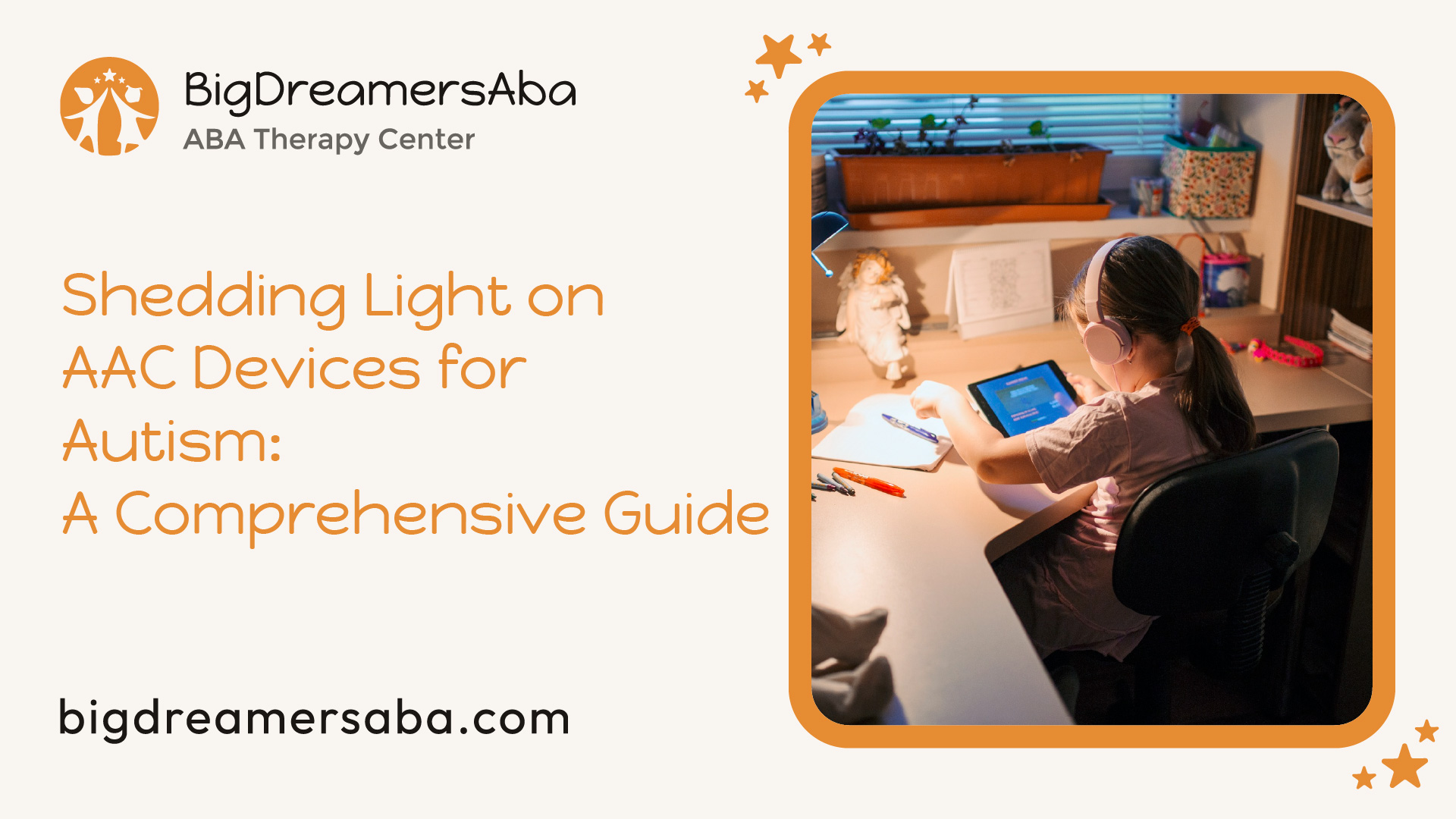Shedding Light on AAC Devices for Autism: A Comprehensive Guide
Discover what is an AAC device for autism and how it enhances communication and support for individuals.


Understanding AAC Devices for Autism
Importance of AAC for Autism
Augmentative and Alternative Communication (AAC) is essential for individuals with autism who face communication challenges. AAC facilitates independence, broadens communication opportunities, and enhances social interactions for those with speech difficulties [1]. AAC devices encompass a range of tools and technologies designed to help individuals express themselves effectively. These devices can include communication boards, speech-generating devices, and text-to-speech applications on electronic devices.
The significance of AAC stems from its ability to support not only verbal communication but also basic expression of needs and thoughts. For many living with autism, traditional verbal communication may pose challenges, making AAC a valuable alternative.
Growth in AAC Industry
The AAC industry has seen significant growth over the past several decades, responding to the increasing demand for effective communication solutions for individuals with developmental disabilities, including autism. Voice output communication devices have been utilized for over 50 years to assist these individuals in overcoming communication barriers.
As technology has advanced, a wider variety of AAC devices have become available, catering to different needs and abilities. Notably, innovations such as tablet-based applications and customizable speech-generating devices have made AAC more accessible than ever.
YearAAC Device Development1970sEmergence of voice output communication devices1980sIntroduction of software-based AAC applications2000sRise of tablet and smartphone AAC applications2020sExpansion of personalized AAC solutions and features
This growth trend highlights the ongoing commitment to enhancing communication options for those with autism and related communication disorders. The collaboration among Speech-Language Pathologists (SLPs), occupational therapists, and physical therapists ensures that AAC systems are tailored to fit individual needs, allowing individuals with movement limitations or other challenges to engage effectively with the technology [4].
Understanding what an AAC device for autism is crucial for caregivers and professionals to provide suitable support and resources, fostering improved communication skills for individuals with autism.
Popular AAC Devices for Autism

AAC devices play a crucial role in helping individuals with autism communicate effectively. Here, we will explore some of the most popular AAC devices available today.
Tobii Dynavox AAC Device
The Tobii Dynavox AAC device is known for its flexibility and durability. It utilizes TD Snap software, which encourages users to employ frequently occurring words in their communication. This streamlined approach can significantly enhance a user's ability to express their needs and thoughts [5].
FeatureDescriptionSoftwareTD SnapKey BenefitsEncourages frequent word usage, durableWarrantyIncluded for parents
The device is designed to adapt to various communication needs and is backed by a warranty, providing additional peace of mind for parents.
AbleNet QuickTalker Freestyle AAC Device
The AbleNet QuickTalker Freestyle AAC device is recognized for its robust construction. This device allows users to load one AAC app from a variety of popular options, including the Proloquo2Go app, which is based on clinical expertise and research in the field of augmentative and alternative communication.
FeatureDescriptionApp CompatibilitySupports popular AAC apps like Proloquo2GoDurabilityRobust design for everyday useVocalization OptionsCustomizable for individual needs
This capability allows for personalization in communication, making it a versatile option for users.
PRC-Saltillo Accent AAC Device
The PRC-Saltillo Accent AAC device is distinguished for its durability and the use of LAMP Words for Life software, a research-backed method for language development. This device supports users in developing their language skills while promoting effective communication strategies [5].
FeatureDescriptionSoftwareLAMP Words for LifeKey BenefitsSupports language development, highly durableResearch BackingEvidence-based approach
Its combination of robust features and research foundations makes this device a strong contender for those looking to enhance their communication capabilities.
These popular AAC devices provide essential support for communication in individuals with autism, helping them express themselves more effectively. For further insights into various strategies related to autism, visit our article on calming strategies for kids with autism.
Benefits of AAC for Autism

AAC (Augmentative and Alternative Communication) devices offer significant advantages for individuals with autism, particularly in developing communication skills and supporting verbal speech.
Development of Communication Skills
AAC systems provide an effective way for individuals with autism to communicate. Research indicates that these devices enhance communication development, enabling users to learn new words and expand their vocabulary. With regular use, children can form phrases and sentences which lead to independent and spontaneous communication.
A meta-analysis of 24 studies demonstrated strong effects on communication skills in autistic children and young adults who utilized aided AAC. This indicates that integrating these devices can play a crucial role in fostering effective communication a vital skill in social interactions [6].
Communication SkillImpact of AACVocabulary ExpansionEnhanced learning of new wordsSentence FormationImproved ability to create phrasesIndependent CommunicationIncreased spontaneous interactions
Additionally, 25%–35% of autistic children are considered "minimally verbal," using fewer than 20 spoken functional words even after early intervention [6]. AAC can bridge this gap by providing a reliable communication alternative for these individuals.
Support for Verbal Speech
Contrary to common concerns, the use of AAC does not hinder the development of verbal communication. In fact, research shows that AAC systems can actively support the growth of verbal speech and language skills [4]. Individuals using these devices often demonstrate improved literacy skills as well, highlighting the comprehensive benefits of integrating AAC into their communication strategies.
Effective AAC interventions primarily target functional communication, such as making requests, which forms the bedrock of many verbal interactions. This approach indicates that AAC not only facilitates communication but also strengthens foundational skills essential for developing verbal capabilities [7].
Verbal Speech DevelopmentImpact of AACLanguage GrowthEnhanced vocabulary and expressionSpeech IndependenceFostering spontaneous verbalizationLiteracy SkillsImproved reading and writing abilities
In summary, AAC devices serve as a crucial tool for enhancing communication skills and supporting verbal speech for individuals with autism. Understanding the benefits of these systems can enhance how support structures are formed for individuals on the autism spectrum. For more insights on autism and its related challenges, visit our articles on early signs of autism in babies and kids and calming strategies for kids with autism.
Considerations for Introducing AAC Devices
Introducing AAC devices is an important step for enhancing communication among individuals with Autism Spectrum Disorder (ASD). There are several key considerations to keep in mind when implementing these devices effectively.
Integration with Other Therapies
To maximize the effectiveness of AAC devices, it is essential to integrate them with other therapeutic approaches. Collaboration among professionals, such as Speech-Language Pathologists (SLPs), occupational therapists, and physical therapists, is often vital to determine the best methods for utilizing AAC systems. These professionals can help tailor the device to meet the individual needs of the user, especially for those with movement limitations who may require alternative interaction methods beyond manual touch [4].
Additionally, incorporating the AAC device into daily routines can help reinforce communication skills. By encouraging use across various settings, including home, school, and therapy sessions, the individual can practice communication in diverse contexts. This holistic approach often leads to better outcomes in developing effective communication strategies.
Cost and Funding Assistance
The cost of AAC devices can be a significant factor for families and individuals seeking these tools. Generally, if a child or student undergoes an assistive technology evaluation through their school district, the district is responsible for covering the cost of the AAC device. This often includes a range of assessments to determine the most suitable device for the individual's needs [8].
For adults or those outside of a school setting, nonprofit organizations and government programs may provide funding assistance to help offset costs. Exploring these options is crucial to making AAC devices accessible to those who need them. It is advisable to reach out to local resources, support groups, and organizations focused on autism to inquire about available funding opportunities.
By considering these aspects of integration with therapies and financial assistance, families and caregivers can more effectively support individuals with autism in their communication journey.
Types of AAC Devices for Autism
Understanding the different types of Augmentative and Alternative Communication (AAC) devices is essential for effectively supporting individuals with autism. These devices are categorized as no-tech, low-tech, and high-tech, each with its unique features and applications.
No-Tech, Low-Tech, High-Tech Options
AAC solutions can be broadly classified into three categories:
TypeDescriptionExamplesNo-TechUtilizes natural methods of communication without any technology.Picture cards, gestures, and sign languageLow-TechInvolves simple tools that do not rely on electronics.Communication boards, printed symbolsHigh-TechComprises sophisticated electronic devices with software capabilities.Voice output devices, tablets with AAC applications, dedicated AAC devices
No-tech options involve techniques such as gestures or sign language. These methods often rely on visual and physical cues, allowing individuals to express themselves without the aid of technology. Low-tech options utilize printed materials or boards where users can point or select symbols to communicate.
High-tech AAC devices, which include electronic tools such as speech-generating devices (SGDs), are rapidly evolving. They integrate hardware and software to translate users' intended messages into spoken words. Despite their potential, high-tech AAC systems often require substantial training and can be costly, which may affect accessibility and usability. Optimizing high-tech AAC use should prioritize communicative needs over system complexities.
Tailoring AAC Devices to Individual Needs
When selecting an AAC device, it's crucial to tailor the choice to the individual's unique communication needs. The effectiveness of an AAC system often hinges on how well it aligns with the user's capabilities and preferences. About 30% of children with autism lacking sufficient speech skills stand to benefit significantly from AAC interventions.
A comprehensive assessment should involve input from caregivers, educators, and speech-language professionals to identify the most suitable AAC option. Factors to consider include:
Voice output communication devices have been utilized for over 50 years to help individuals with developmental and acquired disabilities communicate effectively. Whether opting for no-tech, low-tech, or high-tech solutions, the right AAC device can significantly improve communication and quality of life for individuals with autism.
References
[2]:
[3]:
[4]:
[5]:
[6]:
[7]:
[8]:
[9]:
Recent articles

How to Create a Structured Home Environment for Children with Autism

Why ABA Therapy Helps Children Build Confidence Through Skill Mastery
